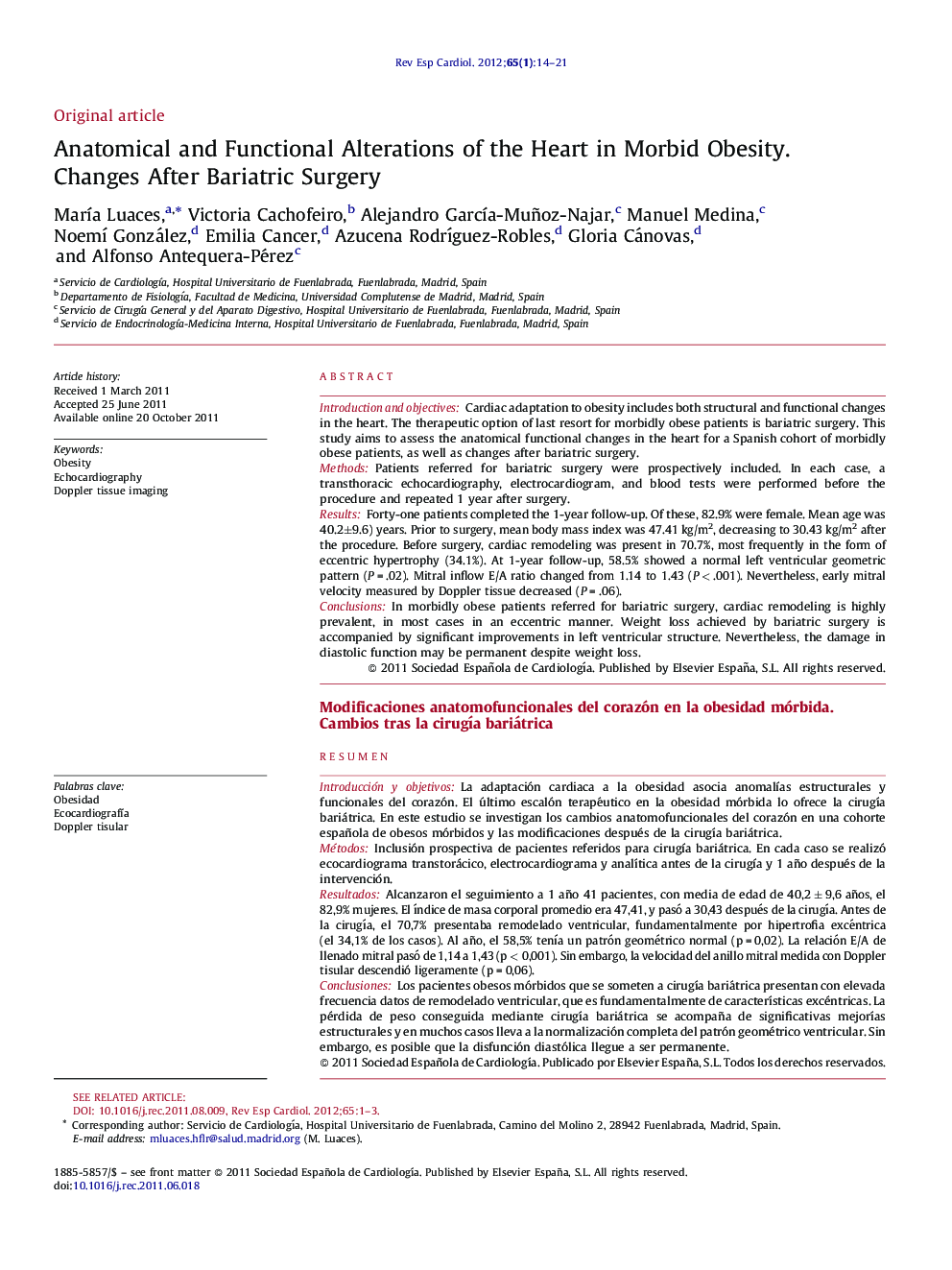| کد مقاله | کد نشریه | سال انتشار | مقاله انگلیسی | نسخه تمام متن |
|---|---|---|---|---|
| 3018136 | 1182152 | 2012 | 8 صفحه PDF | دانلود رایگان |

Introduction and objectivesCardiac adaptation to obesity includes both structural and functional changes in the heart. The therapeutic option of last resort for morbidly obese patients is bariatric surgery. This study aims to assess the anatomical functional changes in the heart for a Spanish cohort of morbidly obese patients, as well as changes after bariatric surgery.MethodsPatients referred for bariatric surgery were prospectively included. In each case, a transthoracic echocardiography, electrocardiogram, and blood tests were performed before the procedure and repeated 1 year after surgery.ResultsForty-one patients completed the 1-year follow-up. Of these, 82.9% were female. Mean age was 40.2±9.6) years. Prior to surgery, mean body mass index was 47.41 kg/m2, decreasing to 30.43 kg/m2 after the procedure. Before surgery, cardiac remodeling was present in 70.7%, most frequently in the form of eccentric hypertrophy (34.1%). At 1-year follow-up, 58.5% showed a normal left ventricular geometric pattern (P = .02). Mitral inflow E/A ratio changed from 1.14 to 1.43 (P < .001). Nevertheless, early mitral velocity measured by Doppler tissue decreased (P = .06).ConclusionsIn morbidly obese patients referred for bariatric surgery, cardiac remodeling is highly prevalent, in most cases in an eccentric manner. Weight loss achieved by bariatric surgery is accompanied by significant improvements in left ventricular structure. Nevertheless, the damage in diastolic function may be permanent despite weight loss.
ResumenIntroducción y objetivosLa adaptación cardiaca a la obesidad asocia anomalías estructurales y funcionales del corazón. El último escalón terapéutico en la obesidad mórbida lo ofrece la cirugía bariátrica. En este estudio se investigan los cambios anatomofuncionales del corazón en una cohorte española de obesos mórbidos y las modificaciones después de la cirugía bariátrica.MétodosInclusión prospectiva de pacientes referidos para cirugía bariátrica. En cada caso se realizó ecocardiograma transtorácico, electrocardiograma y analítica antes de la cirugía y 1 año después de la intervención.ResultadosAlcanzaron el seguimiento a 1 año 41 pacientes, con media de edad de 40,2 ± 9,6 años, el 82,9% mujeres. El índice de masa corporal promedio era 47,41, y pasó a 30,43 después de la cirugía. Antes de la cirugía, el 70,7% presentaba remodelado ventricular, fundamentalmente por hipertrofia excéntrica (el 34,1% de los casos). Al año, el 58,5% tenía un patrón geométrico normal (p = 0,02). La relación E/A de llenado mitral pasó de 1,14 a 1,43 (p < 0,001). Sin embargo, la velocidad del anillo mitral medida con Doppler tisular descendió ligeramente (p = 0,06).ConclusionesLos pacientes obesos mórbidos que se someten a cirugía bariátrica presentan con elevada frecuencia datos de remodelado ventricular, que es fundamentalmente de características excéntricas. La pérdida de peso conseguida mediante cirugía bariátrica se acompaña de significativas mejorías estructurales y en muchos casos lleva a la normalización completa del patrón geométrico ventricular. Sin embargo, es posible que la disfunción diastólica llegue a ser permanente.
Journal: Revista Española de Cardiología (English Edition) - Volume 65, Issue 1, January 2012, Pages 14–21